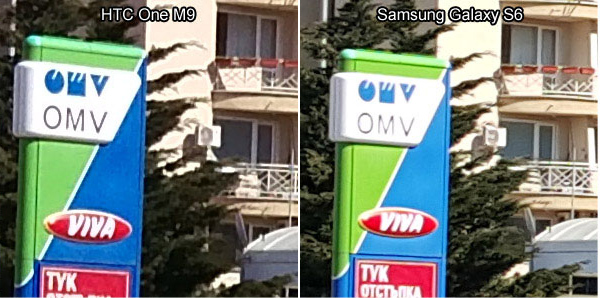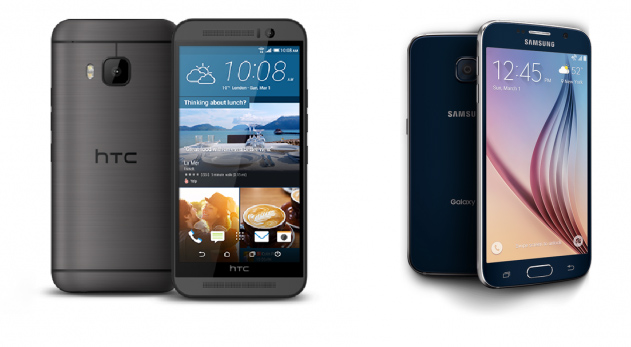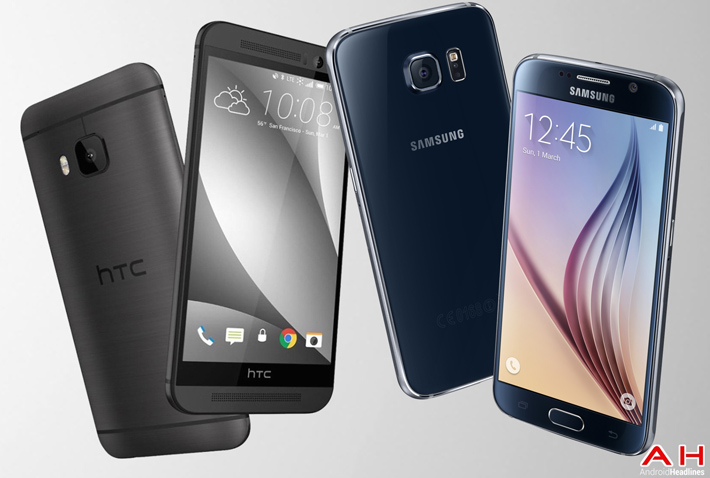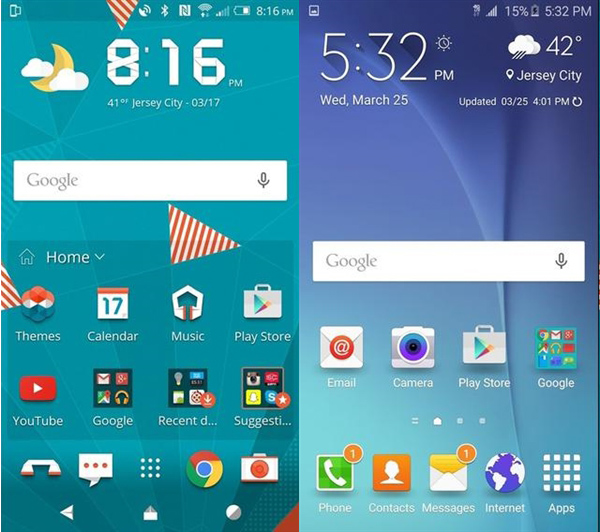There are two big Android phones as the frontrunners on the market right now – the HTC One M9 and the Samsung Galaxy S6. HTC and Samsung have diehard fans on either side that’ll no doubt get their latest phones, but what if you just want to get the best phone on the market? That’s where we come in.
Let’s see how the two phones stack up in a few key areas, then we’ll take a more detailed look at the phones’ design, hardware, camera and software. Only then can we decide – HTC One M9 or Samsung Galaxy S6?
| HTC One M9 | Samsung Galaxy S6 | |
| Display | 5-inch 1080p IPS | 5.1-inch 1440p AMOLED |
| Cameras | 21 MP / 4 MP | 16 MP / 5 MP |
| CPU | Snapdragon 810 Octa | Exynos 7420 Octa |
| RAM | 3GB | 3GB |
| Storage | 32GB + micro SD | 32 / 64 / 128GB |
| Battery | 2840 mAh (62 hr endurance) | 2550 mAh (73 hr endurance) |
| Android | 5.0 Lollipop + Sense | 5.0 Lollipop + TouchWiz |
| Design | Aluminium unibody Gunmetal, gold on silver, gold |
Aluminium frame + glass back White, black, gold, blue |
Design
The One M9 continues the legacy of the One M8 and One M7, with its handsome aluminium unibody design and dual front-facing speakers. That makes for a rather tall phone, but it does feel solid in the hand and looks great. The only issue is that all the changes from One M7 to One M9 are incremental; to a casual observer the phones look and feel identical. That won’t bother HTC diehards, but for those looking for the new hotness it’s a definite drawback.
Meanwhile, Samsung have shaped up considerably between the Galaxy S5 and Galaxy S6. New materials – glass for the back and aluminium for the frame – make for a dramatically better-looking and better-feeling phone. Combined with Samsung’s traditionally slim design, it’s an impressive effect – and that goes double for the curved-screen S6 Edge variant. It’s still a little ways off from the engineering excellence of HTC’s effort, but it is brand new for this year, and that definitely counts for something… even if the glass picks up fingerprints like no other.
Design verdict: Draw
Hardware
When it comes to hardware, both phones have a reasonable claim to fame. The Galaxy S6 comes with a super-dense 5.1-inch 2560 x 1440 display and Samsung’s latest octa-core processor, which has topped benchmark leaderboards since its introduction. That’s backed with faster flash storage and the option for more capacious internal storage than the One M9. A 2550 mAh battery is the lone regression, down 50 mAh from the Galaxy S5.
On HTC’s side of the court, we have a 5-inch 1920 x 1080 display and Qualcomm’s latest Snapdragon 810 octa-core processor. The One M9 only comes with 32GB of built-in storage, but also includes a micro SD card slot to add up to 128GB of storage very cheaply. Finally, the One M9 has a larger 2840 mAh battery.
While the One M9 does eclipse the vast majority of Android phones on the market, it’s Samsung’s Galaxy S6 that surpasses it in almost every area: Processor, display, storage speed, even battery life despite the smaller capacity. Where so many Android phone makers are using Qualcomm’s latest chips, Samsung has carved out an advantage by using its own chipsets and paying attentions to details like faster flash storage and faster RAM. Despite the loss of micro SD storage, that gives Samsung the edge.
Hardware verdict: Advantage Samsung
Camera
The camera battle is one of the most interesting parts of this rivalry. The One M9 has a massive 20.7-megapixel sensor, behind a f/2.2 aperture, while the Galaxy S6 has a smaller 16-megapixel sensor but wider f/1.9 aperture. The S6 has optical image stabilisation, but the One M9 has a dual-LED dual-tone flash.
When it comes to the front-facing selfie cam, we also have differences. HTC’s phone uses the 4-megapixel Ultrapixel sensor that was on the back of last year’s model, while the Galaxy S6 uses a 5-megapixel model.

Camera test from GSMArena.com, click for more photos.
It looks like Samsung comes out ahead on the rear camera stakes. That’s down to better image processing for Samsung, which captures a wider dynamic range and more detail. Things are a bit closer in low-light situations, particularly with flash, but on average you’ll get better photos more often with the Galaxy S6.
It’s reversed for the front-facing camera, where HTC impresses with better contrast and a more convenient 16:9 aspect ratio.
Most people will take more photos with the rear-facing camera than they will with the front, so we’ll call this a strong win for Samsung.
Camera verdict: Advantage Samsung
Software & features
The software battle is as close as it’s ever been. Both companies have reigned in their customisations over the past couple of years, with the latest iterations of TouchWiz and Sense much closer to Google’s stock version of Android. Both interfaces can now be modified with themes, letting you get a radically different look right out of the box.
While interface customisations are a matter of taste, it’s Samsung that seem to have the edge when it comes to features. Two big wins for Samsung are the fingerprint sensor embedded in the home button that offers more convenient security, and the multi-window feature that makes multitasking easier on the large screen.
Software and features verdict: Advantage Samsung
Conclusion
So there we have it – two very evenly matched phones, but it’s the Samsung Galaxy S6 that wins all but one category of our head-to-head (and the popular vote thus far!).
Which is your favourite? Let us know in the comments below! You can also reach us on Twitter @mobilefun!


